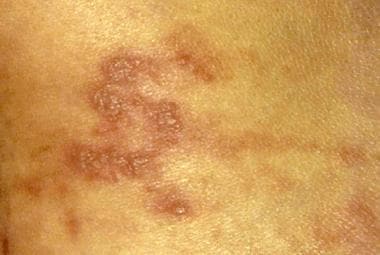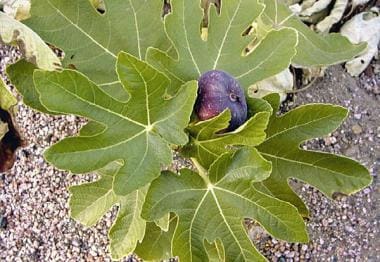Practice Essentials
Phytophotodermatitis (PPD) is a phototoxic inflammatory dermal reaction mimicking a burn injury. It is induced by exposure to certain light-sensitizing plant products (usually sap and fruits), most often furocoumarins, followed by exposure to long-wave ultraviolet light (UV-A 320-380 nm). [1] Both components (plant and light) are required; neither agent alone can cause phytophotodermatitis. It is not an allergic reaction.
The phototoxic inflammatory eruption usually appears 24 hours after exposure and peaks within 48-72 hours. Initial burning erythema is followed by blistering, epidermal necrosis (shown in the photo below), and desquamation. The reaction can be linear or streaked in morphology. This acute process may be followed by postinflammatory irregular hyperpigmentation that can last weeks to months. [2]
 Phytophotodermatitis. Close-up view of vesicular linear streaks with morphology suggestive of scattered foci of epidermal necrosis.
Phytophotodermatitis. Close-up view of vesicular linear streaks with morphology suggestive of scattered foci of epidermal necrosis.
Risk of PPD is elevated in vegetable and citrus harvesters (especially citrus and celery), hikers, and gardeners, as they come in commonly come into contact with plant parts. Children who play with plants and around plants are also at higher risk. Notably, lime juice is a common source of PPD, so bartenders and anyone preparing beverages with lime and citrus juice is at higher risk. [3, 4]
PPD is a clinical diagnosis. See Presentation and Workup.
Treatment of the acute inflammatory condition is based on severity of symptoms, as follows:
-
Mild reactions - Cool wet dressings, topical steroids, and nonsteroidal anti-inflammatory drugs (NSAIDs)
-
Severe reactions - Consider systemic corticosteroids; rarely, patients with severe cases need admission and care in a burn unit.
See Treatment for more detail.
Pathophysiology
Phototoxic dermatitis is 1 of the 4 mechanisms of cutaneous inflammation produced by plant exposure. Plants may also cause irritant contact dermatitis, urticarial dermatitis, or allergic contact dermatitis. [7]
Phytophotodermatitis (PPD) can occur through ingestion of the plant or, more commonly, through topical contact. Furocoumarins (bergaptol, xanthotal, 5-methoxypsoralens, 8-methoxypsoralens, angelican) are the major photoreactive essential plant oils involved in PPD. Plants are thought to produce furocoumarins for disease resistance.
Melough and collegues measured the total furocoumarin concentration in various foods and beverages and showed that grapefruit juice (95341 ng/g), fresh parsley (23215 ng/g), grapefruits (21858 ng/g), lime juice (14580 ng/g), limes (9151 ng/g), and lemon juice (1561 ng/g) had the greatest concentration of furocoumarins. Additional foods with high furocoumarin concentration included celeriac (also known as turnip-rooted celery, celery root, or knob celery) (396 ng/g), parsnips (335 ng/g), and carrots (68 ng/g). [8]
Furocoumarins are lipid soluble and absorbed into keratinocytes. Exposure to certain wavelengths of ultraviolet A (UV-A 320-380 nm) light enables furocoumarins to absorb energy, thereby altering reactivity of the molecular structure and causing it to attain a high-energy state. [9] In the presence of oxygen, activated molecules form photoaddition products with DNA pyrimidine bases via DNA interstrand crosslinking at cytosine and thymidine with the furan ring of the psoralen and result in epidermal cell nucleic acid damage (type I reaction). In the absence of oxygen, activated furocoumarins can also produce oxygen, superoxide, and hydroxy radicals, which cause cellular membrane damage (type II reaction).
Both mechanisms result in arachidonic acid pathway activation, cellular dysfunction, cellular death, and tissue destruction. When acute, the process is phototoxic.
The chronic presentation of phytophotodermatitis involves a photoallergic response; light-activated plant products act as haptens and produce a cell-mediated hypersensitivity response. Psoralens may not be primarily involved in this chronic mechanism of injury. [10, 11]
Phytophototoxicity is amplified by humidity and perspiration.
Postinflammatory irregular hyperpigmentation may develop and can last weeks to months. Affected areas may remain hypersensitive to ultraviolet light for many years. In some individuals, these pigmentary changes may be the only portion of the process that is noticed, as the initial inflammatory reaction may be minimal. The hyperpigmentation is typically more pronounced in those with darker skin colors.
Irregular hyperpigmentation occurs via 2 mechanisms. Melanin is displaced from the epidermis into the dermis and ingested by melanophages. A larger number of melanocytes and melanosomes are distributed in the epidermis. Hyperpigmentation may be a protective mechanism to avoid additional solar injury. [9]
Etiology
Phytophotodermatitis (PPD) is induced by exposure to certain plants with subsequent exposure to sunlight. PPD can occur through ingestion of the plant or, more commonly, through topical contact.
Members of the following plant families are noted to cause a PPD reaction:
-
Umbelliferae (celery, carrot, parsley)
-
Leguminosae (peas, beans, other legumes)
-
Apiaceae (celery, carrot, parsley)
-
Rutaceae (citrus, rue)
-
Moraceae (mulberry, fig, jackfruit, breadfruit)
-
Rosaceae (rose, apple, plum, peach, almond, cherry)
-
Asteraceae (daisy, sunflower, aster, chrysanthemum)
-
Brassicaceae (mustard, crucifer, cabbage)
-
Clusiaceae (mangosteen)
-
Convolvulaceae (morning glories, sweet potato)
-
Anacardiaceae (cashew, sumac, mango, poison ivy, poison oak)
-
Fabaceae (lupine, alfalfa, clover, peanut, beans)
-
Ranunculaceae (ranunculus, aconitum)
Common plants implicated in these families include celery, giant hogweed, angelica, parsnip, fennel, dill, anise, parsley, lime, lemon, rue, fig, mustard, scurf pea, and chrysanthemums. [12, 9, 13, 14, 15, 16, 17, 18, 19, 20] Photos of two of the common plants are shown below.
 Queen Anne's lace, a member of the Umbelliferae family of plants, is well known to produce a furocoumarin-induced phototoxic eruption.
Queen Anne's lace, a member of the Umbelliferae family of plants, is well known to produce a furocoumarin-induced phototoxic eruption.
 Ficus. The common fig contains furocoumarins and should be considered amidst the list of potential offending agents that cause phytophotodermatitis.
Ficus. The common fig contains furocoumarins and should be considered amidst the list of potential offending agents that cause phytophotodermatitis.
Oil of bergamot, extracted from the rind of fresh bergamot oranges (Citrus bergamia), is commonly used to scent commercial perfumes and colognes. Perfume-induced berloque dermatitis is a specific form of a PPD reaction; areas of skin reaction correspond to areas exposed to perfume.
A case of PPD caused by carrot extract-containing sunscreen has been reported. [21]
As noted before, citrus-induced PPD is also common, especially in the hands and lips.
In fig tree PPD, long-term hypopigmentation has been reported, rather than the typical hyperpigmentation. [22]
Epidemiology
Incidence varies per population and exposure. Individuals who handle produce and receive significant sunlight exposure (eg, field workers, farmers, gardeners, grocery workers, bartenders, vegetarians, persons who use tanning salons, those who work outdoors, and those who go outdoors recreationally) are at an increased risk. Cases of phytophotodermatitis (PPD) more commonly occur in late spring and summer, when furocoumarins are found in increased concentration in plants, and when individuals experience increased ultraviolet light exposure. [23]
No difference exists between United States and international occurrence.
No racial or ethnic predisposition is demonstrated. Cases are more frequently reported in fair-skinned individuals. Both sexes are at equal risk. PPD is seen in all age groups. [23]
Prognosis
Significant long-term skin changes (hyperpigmentation, scarring) can occur with chronic exposure. With the acute burn, secondary wound infection may occur.
Patient Education
Patients should be educated regarding plants that produce phytophototoxicity, in order to avoid skin exposure. Patients should be counseled about the use of gloves and other appropriate skin covering when their work necessitates ongoing exposure to these plant oils and to the sun. Patients should be educated regarding use of appropriate sunscreens when sun-exposed.
-
A 37-year-old white woman presented to the clinic complaining of a rash on the medial part of her right thigh and left arm that was acquired after clearing some weeds in her yard. A phototoxic combination of sunlight and a psoralen-containing plant produced this bizarre linear vesicular eruption.
-
Closer clinical view of bizarre angulated vesicular streaks, which occurred after contact with a plant and ultraviolet light exposure.
-
A 26-year-old female airline flight attendant exposed to lime while serving drinks en route to the Caribbean. During the Caribbean layover, she had significant sun exposure. The combination of lime juice and sun exposure led to a drip-pattern blister formation on the dorsal forearm consistent with phytophotodermatitis. This picture clearly delineates the potential severity of phytophotodermatitis with extensive blister formation.
-
The 2-month follow-up photo of the patient above demonstrates the potential postinflammatory pigmentation changes and scarring that may occur with severe blistering of phytophotodermatitis.
-
Phytophotodermatitis. Close-up view of vesicular linear streaks with morphology suggestive of scattered foci of epidermal necrosis.
-
Queen Anne's lace, a member of the Umbelliferae family of plants, is well known to produce a furocoumarin-induced phototoxic eruption.
-
Ficus. The common fig contains furocoumarins and should be considered amidst the list of potential offending agents that cause phytophotodermatitis.









